Gaming the Connections: from Sherlock H to Nada B
[ by Charles Cameron — the game of Connect the Dots in play and practice ]
.
Manhunt, the HBO documentary, does what (not having been there and seen that at the time) appears to be a decent job of recreating some of the cognitive stratregies employed by CIA officers in the OBL hunt. The one I’m interested in here is the building of a “link chart” or cognitive map — law enforcement “evidence board” — the idea being (a) to note known connections visibly, and (b) to encourage the mind to make intuitive leaps that reveal previously unknown connections between nodes… or “dots”.
Sophisticated software does this sort of thing algorithmically with regard to (eg) network connections via phone-calls, but the human mind is still better than AI at some forms of pattern recognition, and that’s the aspect that interests me here.
Aside:
For more on the cognitive significance of the link chart in Manhunt, see my post Jeff Jonas, Nada Bakos, Cindy Storer and Puzzles.
**
Benedict Cumberbatch‘s Sherlock lays out the way it works —
**
Okay, so one way to visualize connections is to make a fairly random collage of relevant photos, names, dates and places, and tie it together with links of string or ribbon. That’s the equivalent of what in HipBone games terms we’d call a “free-form” game, and it works well for the “divergent”, initial brainstorming phase of thought. But it does little to bottle its own energy, to focus down, to force the mind — in the no less powerful “convergent” phase — into perceiving even more links than occur spontaneously in building the link chart in question.
HipBone‘s preformatted boards take the cognitive process to that second stage. They work on one of the most powerful ingredients in creativity: constraint. Business writer Dave Gray of Communication Nation puts it like this:
Creativity is driven by constraints. When we have limited resources — even when the limits are artificial — creative thinking is enhanced. That’s because the fewer resources you have, the more you are forced to rely on your ingenuity.
But that premise doesn’t just hold true for business problem-solving — it’s at the heart of creative thinking at the Nobel level, too, in both arts and sciences. Consider mathematician Stanley Ulam, writing in his Adventures of a Mathematician:
When I was a boy I felt that the role of rhyme in poetry was to compel one to find the unobvious because of the necessity of finding a word which rhymes. This forces novel associations and almost guarantees deviations from routine chains or trains of thought. It becomes paradoxically a sort of automatic mechanism of originality…
Here’s how the poet TS Eliot puts it:
When forced to work within a strict framework the imagination is taxed to its utmost – and will produce its richest ideas.
A Hipbone Gameboard such as the Waterbird, Dartboard, or Said Symphony board is chosen precisely to challenge the mind with third, fourth and fifth rounds of “creative leaps” — thus adding both divergent and convergent cognitive styles to this form of graphical analysis.
That’s my point here — and a plug for HipBone-Sembl style thinking.
**
I can’t resist adding a couple of instances in which the meme of “connecting the dots” via a link chart or evidence board has crept from TV series that I enjoyed into the world of games — this first one based on the terrific French detective series, Engrenages, retitled Spirals for British consumption:
— and this one for fans of the US TV series, Breaking Bad:


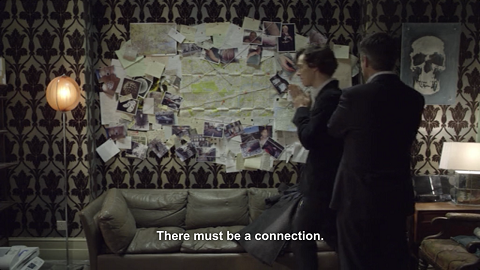
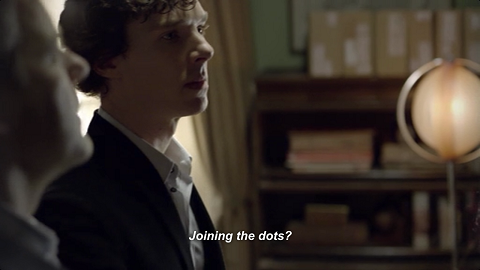
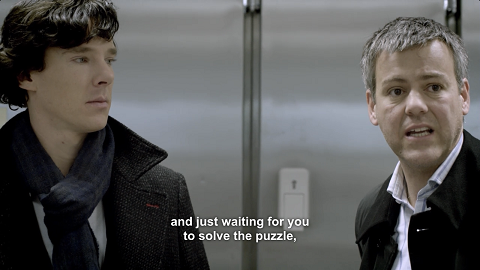
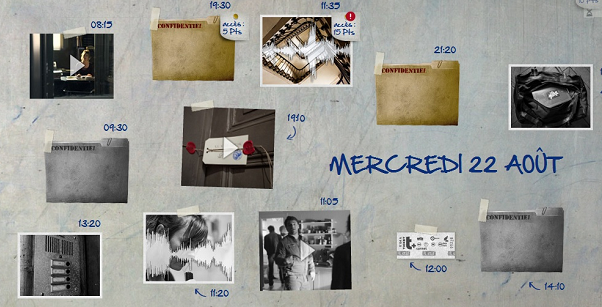
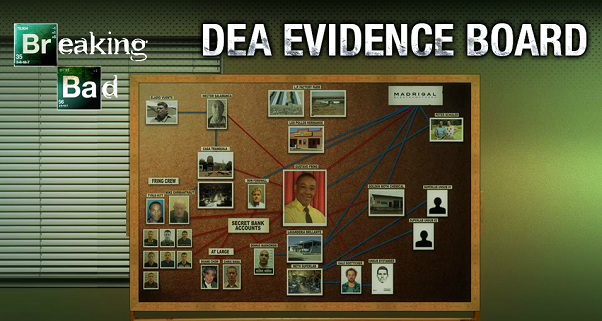



December 30th, 2013 at 2:19 am
“if you wish to fence in a bull, give him a large meadow” – Zen proverb
.
It has been a long time since I picked up a brush or a drawing pencil but there is a certain paralysis in having too large a canvas before you have an idea. What to do with all that negative space? Too many options, too much potential often leads to inaction and infertility of imagination.
.
“ They work on one of the most powerful ingredients in creativity: constraint “
.
There are objective constraints ( the idea must solve our problem to be useful, the idea must result in an object smaller than “x” dimensions to fit “y” space) and then there are unwarranted constraints in the form of mistaken assumptions about a situation or problem that are subjective but result in limiting creative thinking by creating a mental “box” in which to be inside. These constraints are bad and should be jettisoned
December 30th, 2013 at 5:00 am
Nice zen proverb, Zen.
.
And yes, I’m with you on assumptions being an ignoble form of constraint. My overall point, though, is that the imposition of additional “formal” constraints by the creative mind (complex rhyme schemes, eg) will often result in increased “mind play” to satisfy those constraints, thereby adding further insights into the mix…
.
Somewhere I have an ancient essay about this, using specific examples from poetry, which I will post if I ever find it.
December 30th, 2013 at 12:40 pm
In advertising, design, fashion and many other fields that require creative conceptualization/ ideation, similar collages are used that they call mood boards.
It’s essentially strategic scrapbooking.
I see Pinterist used a lot for it.
December 30th, 2013 at 6:50 pm
Indeed, Grurray, and thanks.
.
My major point, though, is that if the items (at nodes) of the “mood board” were additionally required to fit the tight format of a preset HipBone board — eg a total of eight nodes with the Dart board, ten with the Waterboard, and with the requirement that additional “links” should be claimed according to the board layout, the creative insights obtained would in fact increase.
December 30th, 2013 at 7:15 pm
Would the HipBone board, considering where the name “HipBone” comes from, be similar to a board with eight disciples and 10 tribes? So the “additional ‘links'” are conquered territories, or at least links of the Westphalia nature?
December 30th, 2013 at 7:30 pm
Larry, you’ve outdone yourself.
.
I’ll post a proper reply later, but for now I must rush out the door, my drive awaits…
December 30th, 2013 at 8:45 pm
Another fascinating post. Having been there and done that in LE I would add there is almost always some type of organizing principle or concept involved, not just trying to look at random data for connection. Examples would be a Timeline or some concept like my 4F’s. Family,Friends,Finances and that F word for very intimate relationships, it was very useful in understanding the power dynamic of a criminal group.
.
I just watched a C-SPAN2 inteview recently where they interviewed the past staff members of the Warren Comission. Being staff memebers these are the people that actually did the work. One person along with IRS agents took the bank accounts of Oswald and then mapped every location where he spent money in order to develop his pattern of activities and then they went to each location and spoke to the people there to try and obtain any and all information about Oswald, some fascinating detils were turned up. Sometimes the old ways are better than the new.
December 31st, 2013 at 1:07 am
Ah, Slapout — I thoiught that word “random” — in “to make a fairly random collage of relevant photos, names, dates and places” — might trip me up, which is why I tried to balance it with “relevant”. Good catch — and I appreciate your point about the 4Fs, which from my POV would serve as a very helpful “constraint set”.
.
But to get back to my word. “random”…
.
By “a fairly random collage” I meant to imply one in which the board positions of individual names, dates, images etc were somewhat haphazard — a photo might be placed where there’s a vacant space on the board, eg, so that even though the photo itself if not random (it’s a “relevant” photo), its placement may not be. Of course, if there’s a document relating to the photo, they may be put (non-randomly) close together for that reason.
.
But what might happen if a whole different set of semi-random placements of the same relevant dates, docs and faces were made — so that some things far separated in instance #1 were close in instance #2, and some close in #1 far distant in #2? Would a different set of “maybe this connects with that” thought arise, in line with the new set of proximities and my proposition (b) above — ie making intuitive leaps that reveal previously unknown connections?.
.
I suspect there are a number of ways in which one could “tweak” link maps & evidence boards (and mind maps, etc) to get more “juice” out of them. I’m betting that adding constraints would be one of them.
December 31st, 2013 at 1:13 am
Hi Larry:
.
HipBone comes from the gospel song, Dem Bones:
.
.
— which in turn is derived from Ezekiel’s vision of the Valley of Dry Bones in Ezekiel 37 — so from my POV the name serves a double purpose.
.
On the one hand, it refers to connectedness, since my games are about the connections between ideas. That’s the connection to the “form” ov the games. On the other hand, it also references Ezekiel, and thus apocalyptic — the topic which most interests me from a research point of view.
.
So — great guess, not quite — but close enough to deserve the cigar anyway!
December 31st, 2013 at 4:08 pm
Ahh, I found your game boards and now I see what you’ve been getting at.
“These linkages teach an important cognitive skill, lateral or creative thinking, while reinforcing the factual knowledge displayed in answering the questions correctly”
Looks like fun.
One question about your board: the configuration is interesting. 9 seems to be the high scoring node (high five). Is there any additional significance to the layout? It looks pretty cool regardless.
December 31st, 2013 at 8:29 pm
For those who don’t know them, my Games use boards that have a preset number of nodes, and a preset pattern of links between them. The most commonly used board, and the one Grurray is referring to, is the WaterBird:

.
.
As Grurray mentioned and you can see, the position labeled 9 has more direct connections (to 2,3,4,5,6,7,8 and 10) than any other on the board — and any move (concept, idea) played in that position will need to link with any moves in those positions already in play.
.
Mostly when the games are played, they are played collaboratively rather than competitively, so position 9 isn’t the highest scoring position but the strategically tricky one — play an idea in that node / position too early, and your move will dominate the rest of the game; play that node too late, and you will have to find an idea with individual links to all or almost all the moves already in play, which can prove a formidable task…
.
When I started playing the games, I did so using the geometry of the Tree of Life from classical kabbalah as my board…
.
…but then it occurred to me that serious kabbalists might not appreciate that use of their sacred geometry, so I designed the WaterBird to be a similar board, but without the sacred connotations. Once I’d designed it, however, I found the design reminded me of the “WaterBird” of Native American peyote ceremonials — so I note that it’s hard to escape spiritual influences when dealing with geometry, and added some color to the board to emphasize the bird’s wings and tail…
December 31st, 2013 at 8:30 pm
OK, never mind, I dug a little bit more into your explanations. That makes sense
December 31st, 2013 at 10:27 pm
“These linkages teach an important cognitive skill, lateral or creative thinking, while reinforcing the factual knowledge displayed in answering the questions correctly”
*
Ok, I understand, it was my first question, but did I answer it correctly enough?
*
I only connected in one direction, but it seems, by the geometry of your board, that the connects in the first move is by three connects and not two, as in your answer. By that I mean, you only seem to connect Hipbone in two directions.
*
Also, a network is made up of both edges and nodes. Does your game play not only the friction in nodes, but the friction across the edges as well, as the color seems to represent? Or do you account for friction at all in the network?
January 1st, 2014 at 7:23 pm
“But what might happen if a whole different set of semi-random placements of the same relevant dates, docs and faces were made — so that some things far separated in instance #1 were close in instance #2, and some close in #1 far distant in #2?”
*
I am not a systems expert, but when you move the nodes you are also moving the edges as well. At least you are moving what you are Observing mentally. In your game the implicit is important. So what you could end up with is a whole new network map, with not only edges redrawn, but with nodes splitting up or added and the geometry ever expanding.
*
In other words, despite your efforts to change the geometry so as not to offend other beliefs, the geometry could change right back into some form that you started with, or not. It could change into something completely else.
*
You may have constraints, but by changing relationships you are changing the narrative and, in the process, the player may loosen constraints as well.
*
But then maybe it could be thought of as: it’s the constraints which may be forcing the algorithms of the game to change implicitly first and nearly automatic. Which Google and Facebook, to name just a few, have their algorithms changing all the time, but they let the constraints of the market do the changing.
*
It seems to me that what your game really accomplishes is a margin of control in a complex environment. It tries to make the environment complicated instead of complex. I mean if it was complex, strategy would be the best bet, so #10 question would be: what does the End look like.
January 4th, 2014 at 5:34 pm
I’ve been, and am still, on deadline, so please forgive the tardiness & brevity of this response.
.
I will only touch on a few things.
The first move can be in any of the positions on the board, there’s no prescribed order — though some games are played sequentially, position 1 through 10 — the number system is only there to idenify which position a player is moving (or has already moved) into.
.
And I’m not “playing a move on a board” when I name the two ways the name HipBone is resonant for me, just telling you why I chose the name.
In a game for intellectual play & delight, the board configuration remains constant. In applying the game constraints & board to an existing evidence map, the “players” / analysts might need to collapse some nodes into others (by abstracting to a higher level) and how to explain links (required by the board configuration) they hadn’t otherwise seen. But an analytic use would be essentially a brainstorming use, so it doesn’t really matter if the rules of the “game version” aren’t strictly followed. The idea in this case is to stir up fresh thinking, not to complete a formal game.
Something along those lines, yes, if I understand you aright…
January 6th, 2014 at 9:58 pm
“Something along those lines, yes, if I understand you aright…”
*
It sounds like someone up there in pundit-land likes me, but from the structure of your answer it seems to me that person wasn’t you. After all, as editor, you need to keep it all together in harmony (between being and doing), and for that you need help.
*
And that probably wasn’t a bad move, but on what number?
*
Don’t I need the number to understand the “edges”? 🙂
January 6th, 2014 at 10:14 pm
“In a game for intellectual play & delight, the board configuration remains constant.”
*
I mean the game may be, “for intellectual play & delight”, but to me it looks like what I describe as a gap between two OODA loops, or war. And in this case, because of how it is structured, the war looks more civil than between nations.
*
I mean, as I have said before, I see the loop as much of a particle wave as a loop. A wave can keep forming itself over and over again, but if it’s a civil war all “waves” occupy the same space, but the edges are distorted, and because of this distortion. I just happen to think there is a “gap” between waves, and the gap looks very similar to your board. It could mean nothing at all, only I am trying to learn the rule-sets, but, unlike you, I have very little brain-power to play with. 🙂
February 23rd, 2014 at 9:14 pm
“It has been a long time since I picked up a brush or a drawing pencil but there is a certain paralysis in having too large a canvas before you have an idea.”
*
But getting back to Zen, I agree. But there usually is a tipping point. So much of the time you just need to wait for that no-shit-Sherlock moment. Up and until that moment you don’t need either the wide nor narrow (a brush nor a drawing pencil), because length matters, at least it does between generations 🙂